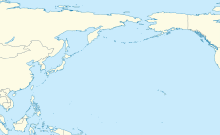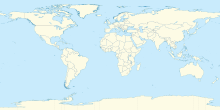Jeju International Airport (IATA: CJU, ICAO: RKPC) is the second-largest airport in South Korea, just behind Incheon Airport in Incheon (near Seoul). It is located in the city of Jeju. The airport opened in 1968.
Jeju International Airport 제주국제공항 | |||||||||||||||
|---|---|---|---|---|---|---|---|---|---|---|---|---|---|---|---|
 | |||||||||||||||
| Summary | |||||||||||||||
| Airport type | Public | ||||||||||||||
| Owner | Ministry of Land, Infrastructure and Transport | ||||||||||||||
| Operator | Korea Airports Corporation | ||||||||||||||
| Serves | Jeju Island | ||||||||||||||
| Location | Jeju City, Jeju Province, South Korea | ||||||||||||||
| Opened | 26 April 1968 | ||||||||||||||
| Focus city for | |||||||||||||||
| Operating base for | |||||||||||||||
| Elevation AMSL | 36 m / 118 ft | ||||||||||||||
| Coordinates | 33°30′41″N 126°29′35″E / 33.51139°N 126.49306°E | ||||||||||||||
| Website | www | ||||||||||||||
| Map | |||||||||||||||
| Runways | |||||||||||||||
| |||||||||||||||
| Statistics (2019) | |||||||||||||||
| |||||||||||||||
| Jeju International Airport | |
| Hangul | 제주국제공항 |
|---|---|
| Hanja | 濟州國際空港 |
| Revised Romanization | Jeju Gukje Gonghang |
| McCune–Reischauer | Cheju Kukche Konghang |
Jeju International Airport serves many mainland destinations in South Korea, as well as international destinations in mainland China, Hong Kong, Japan, Taiwan, Thailand, Malaysia and Singapore. In 2015, 26,237,562 passengers used the airport. The airport is one endpoint of the world's busiest airline route, Jeju to/from Seoul-Gimpo. In 2019 over 17 million passengers traveled on that route.
Due to the airport operating far beyond its designed passenger capacity, it was announced in 2023 that Jeju's second airport would be constructed in Seongsan-eup, near the southern city of Seogwipo. This US$5.1 billion project has faced significant delays and controversies due to concerns the airport would negatively impact Jeju's groundwater sources, as well as protected species living in the area.[3]
Airlines and destinations
editTraffic and statistics
editDue to the popularity of Jeju as a holiday spot in South Korea, the air route from Jeju to Seoul is the busiest airline route in the world.[32] In 2019, there were 85,000 flights from eight different airlines, meanwhile, 17 million seats were sold on flights between Gimpo and Jeju.[citation needed]
As Jeju has gained popularity as a resort destination, the number of international visitors from China, Malaysia, Thailand, and Japan has increased. In 1997, Jeju airport handled nine million passengers. In 2019, the airport passed the 30 million milestone despite being designed to handle a maximum of 26 million passengers.[citation needed] In 2020, the number of international visitors dropped due to COVID-19. However, the Seoul-Jeju route remained the busiest in the world and flight delays are still common.[33]
In 2019, the Ministry of Land, Infrastructure, and Transport announced a US$4.18 billion construction plan that would begin in 2021 near Seogwipo City in southern Jeju. The airport would take 50% of the domestic flights to Jeju and would help to transfer flights during bad weather. The airport would accommodate 18.98 million passengers per year.[33] However in 2021 the Minstry of Environment cancelled the plans due to their failure to protect the local environment, including Jeju's extensive groundwater reserves, and protected species in the area, such as the narrow-mouthed frog. A new US$ 5.1 billion airport plan was provisionally approved in 2023 with no project completion date set.[3]
Traffic by calendar year
editGraphs are unavailable due to technical issues. There is more info on Phabricator and on MediaWiki.org. |
| Passenger volume | Change over previous year | Aircraft operations | Cargo tonnage | |
|---|---|---|---|---|
| 1997 | 9,819,129 | 63,134 | 287,204 | |
| 1998 | 7,469,980 |  23.9% 23.9% | 50,979 | 275,899 |
| 1999 | 8,242,134 |  10.3% 10.3% | 49,978 | 290,168 |
| 2000 | 9,125,939 |  10.7% 10.7% | 55,675 | 320,633 |
| 2001 | 9,320,337 |  2.1% 2.1% | 60,597 | 329,895 |
| 2002 | 9,939,700 |  6.6% 6.6% | 68,681 | 337,750 |
| 2003 | 10,802,989 |  8.7% 8.7% | 77,069 | 339,498 |
| 2004 | 11,104,341 |  2.8% 2.8% | 76,075 | 327,325 |
| 2005 | 11,354,925 |  2.3% 2.3% | 73,556 | 317,839 |
| 2006 | 12,109,836 |  6.6% 6.6% | 78,611 | 315,129 |
| 2007 | 12,296,426 |  1.5% 1.5% | 93,073 | 288,453 |
| 2008 | 12,448,084 |  1.2% 1.2% | 95,671 | 225,479 |
| 2009 | 13,643,366 |  9.6% 9.6% | 99,323 | 240,253 |
| 2010 | 15,724,360 |  15.3% 15.3% | 103,426 | 231,287 |
| 2011 | 17,201,878 |  9.4% 9.4% | 112,696 | 251,975 |
| 2012 | 18,443,047 |  7.2% 7.2% | 120,699 | 244,647 |
| 2013 | 20,055,238 |  8.7% 8.7% | 130,454 | 237,328 |
| 2014 | 23,197,796 |  15.7% 15.7% | 145,533 | 275,429 |
| 2015 | 26,237,562 |  13.1% 13.1% | 158,691 | 278,718 |
| 2016 | 29,707,364 |  13.2% 13.2% | 172,742 | 291,494 |
| 2017 | 29,604,363 |  0.35% 0.35% | 167,280 | 275,129 |
| 2018 | 29,455,305 |  0.5% 0.5% | 168,331 | 266,370 |
| 2019 | 31,316,394 |  6.3% 6.3% | 175,366 | 258,847 |
| 2020 | 21,054,696 |  32.8% 32.8% | 138,256 | 171,385 |
| 2021 | 25,802,550 |  22.6% 22.6% | 160,230 | 188,926 |
| 2022 | 29,703,662 |  15.1% 15.1% | 169,624 | 210,962 |
| 2023 | 29,096,271 |  2.0% 2.0% | 167,086 | 202,609 |
| Source: Korea Airports Corporation Traffic Statistics[2] | ||||
Domestic traffic by route
edit| Rank | Airport | Passengers | Aircraft Movements | Carriers |
|---|---|---|---|---|
| 1 | Seoul-Gimpo | 17,250,478 | 95,042 | Air Busan, Air Seoul, Asiana Airlines, Jeju Air, Jin Air, Korean Air, T'way Air |
| 2 | Busan | 3,714,710 | 21,498 | Air Busan, Air Seoul, Jeju Air, Jin Air, Korean Air |
| 3 | Cheongju | 3,172,099 | 18,494 | Aero K, Asiana Airlines, Jeju Air, Jin Air, Korean Air, T'way Air |
| 4 | Daegu | 2,144,594 | 12,587 | Asiana Airlines, Jeju Air, Jin Air, T'way Air |
| 5 | Gwangju | 1,661,178 | 9,907 | Asiana Airlines, Jeju Air, Jin Air, Korean Air, T'way Air |
Busiest international routes
edit| Rank | Airport | Passengers | Aircraft Movements | Carriers |
|---|---|---|---|---|
| 1 | Singapore | 37,282 | 208 | Scoot |
| 2 | Bangkok–Suvarnabhumi | 26,518 | 185 | Jeju Air |
| 3 | Osaka–Kansai | 13,678 | 104 | T'way Air |
| 4 | Taipei–Taoyuan | 4,724 | 38 | Tigerair Taiwan, T'way Air |
| 5 | Xi'an | 4,007 | 50 | Jin Air |
Accidents and incidents
edit- On 5 February 1982, a Republic of Korea Air Force Fairchild C-123 Provider crashed 2.3 miles N of Hallasan Volcano while on approach to land at Jeju in bad weather. All 53 occupants (6 crew, 47 army troops) were killed.[34]
- On 10 August 1994, Korean Air Flight 2033 overran the runway while attempting to land at Jeju International Airport. All 160 persons on board survived.[35]
- On 28 July 2011, Asiana Airlines Flight 991 experienced an in-flight fire and crashed while attempting to divert to Jeju. Both pilots were killed.[36]



